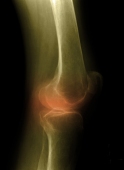
THURSDAY, Feb. 17 (HealthDay News) — Patients with artificial knees were still going strong after 20 years, even jogging or playing tennis, researchers report.
According to the study, most people who had knee replacements between 1975 and 1989 at an Indiana hospital and lived for another 20 years maintained an active lifestyle. All reported at least “moderate” activity.
“The whole point of having a total joint replacement is to maintain a functional knee that allows patients to maintain a good deal of activity for a long time,” said study author Dr. John B. Meding. “This shows it lasts 20 years or more after the [operation].”
“If you get a good knee and treat it well, and are blessed to live long enough, even after 20 years you can maintain this level of activity,” added Meding, an orthopedic surgeon at the Center for Hips and Knee Surgery at St. Francis Hospital Mooresville, in Mooresville, Ind.
The results are scheduled to be presented Thursday at the annual meeting of the American Association of Orthopedic Surgeons in San Diego. Experts caution that research presented at meetings is considered preliminary, however, since it is usually not subjected to the same type of rigorous scrutiny as research published in peer-reviewed medical journals.
Knee replacement surgery, also called knee arthroplasty, is done to relieve pain and restore normal use of the joint, usually for people afflicted by severe arthritis. During the procedure, a surgeon removes damaged bone and cartilage, and implants an artificial knee. The devices are made from plastic, polymers and metal alloys, and are available in different designs geared toward different patients’ needs.
Like all surgeries, the procedure carries certain risks, including the possibility of infection.
In the current study, of 1,757 patients who had knee replacements at St. Francis during the time span examined, 128 were still living after their 20-year follow-up. The average age at the time of the procedure was about 64.
The vast majority of patients in the study had osteoarthritis (82 percent) and most were female (78 percent).
The study participants were assessed for knee flexibility, walking distance, ability to climb stairs and level of pain. All but two patients could use stairs, only three were housebound, and 95 could walk at least five blocks. Many (82) were able to walk indefinitely, and 81 were pain-free. Against doctors’ advice, 22 participated in hard-impact sports — such as jogging, volleyball and tennis — some with both knees replaced.
There are between 300,000 and 500,000 knee replacement surgeries done annually in the United States, said Dr. Howard Luks, an orthopedic surgeon at Westchester Medical Center in Valhalla, N.Y.
The findings are important for younger patients in their late 50s who are considering a knee replacement but are hesitant because they worry it will wear out, said Luks, chief of sports medicine at the facility.
“Until this time, I have been telling my patients the surgery is good for 15 to 20 years, but this is showing good to excellent results that can last 20 years and beyond,” said Luks.
He cautioned that the study needs to be backed up by further research.
“Now I can tell patients there is early evidence showing it can last more than 20 years,” said Luks, “but I can’t say it’s beyond a reasonable doubt.”
The success rate for the procedure is cited at “between 90 and 93 percent,” he said, noting that about 1 percent of patients get infections requiring additional surgery. A “handful of patients” are unhappy with the results, some possibly due to pain, he noted.
The latest findings will allow doctors “to begin a good conversation” with patients considering knee replacement, said Dr. James Barber, an orthopedic surgeon at Coffee Regional Medical Center in Douglas, Ga., who said he was “very encouraged by the results.”
“The key to a good outcome begins with a conversation between doctor and patient who have to come to agreement with regard to expectations,” said Barber. “We don’t have a lot of data so it’s good that we now have this study that shows that these patients are doing well. This allows us to share a great deal of data about what the patient can expect.”
Good results, however, are in the eye of the patient, according to Luks.
“It doesn’t matter if a physical therapist says someone can bend their knee so many degrees,” said Luks. “I base success on when a patient walks into my office and says, ‘Thank you — I’m happy — I can do the things I want to do.’ That’s success.”
More information
For more on knee replacements, visit the Patient Education Institute at the U.S. National Institutes of Health.

